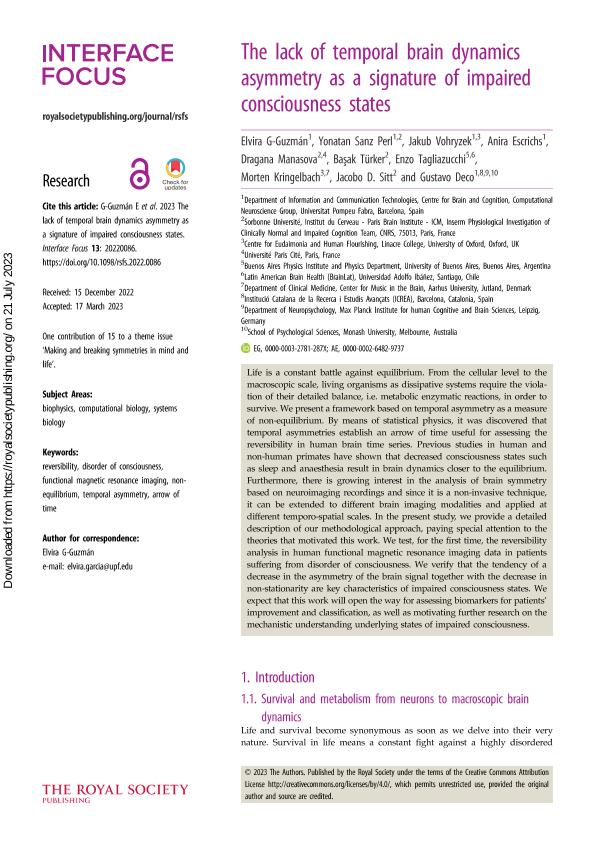Mostrar el registro sencillo del ítem
dc.contributor.author
Guzmán, Elvira G.
dc.contributor.author
Sanz Perl Hernandez, Yonatan

dc.contributor.author
Vohryzek, Jakub
dc.contributor.author
Escrichs, Anira
dc.contributor.author
Manasova, Dragana
dc.contributor.author
Türker, Başak
dc.contributor.author
Tagliazucchi, Enzo Rodolfo

dc.contributor.author
Kringelbach, Morten
dc.contributor.author
Sitt, Jacobo Diego

dc.contributor.author
Deco, Gustavo
dc.date.available
2024-02-27T15:06:50Z
dc.date.issued
2023-04
dc.identifier.citation
Guzmán, Elvira G.; Sanz Perl Hernandez, Yonatan; Vohryzek, Jakub; Escrichs, Anira; Manasova, Dragana; et al.; The lack of temporal brain dynamics asymmetry as a signature of impaired consciousness states; The Royal Society; Interface Focus; 13; 3; 4-2023; 1-15
dc.identifier.issn
2042-8898
dc.identifier.uri
http://hdl.handle.net/11336/228623
dc.description.abstract
Life is a constant battle against equilibrium. From the cellular level to the macroscopic scale, living organisms as dissipative systems require the violation of their detailed balance, i.e. metabolic enzymatic reactions, in order to survive. We present a framework based on temporal asymmetry as a measure of non-equilibrium. By means of statistical physics, it was discovered that temporal asymmetries establish an arrow of time useful for assessing the reversibility in human brain time series. Previous studies in human and non-human primates have shown that decreased consciousness states such as sleep and anaesthesia result in brain dynamics closer to the equilibrium. Furthermore, there is growing interest in the analysis of brain symmetry based on neuroimaging recordings and since it is a non-invasive technique, it can be extended to different brain imaging modalities and applied at different temporo-spatial scales. In the present study, we provide a detailed description of our methodological approach, paying special attention to the theories that motivated this work. We test, for the first time, the reversibility analysis in human functional magnetic resonance imaging data in patients suffering from disorder of consciousness. We verify that the tendency of a decrease in the asymmetry of the brain signal together with the decrease in non-stationarity are key characteristics of impaired consciousness states. We expect that this work will open the way for assessing biomarkers for patients’ improvement and classification, as well as motivating further research on the mechanistic understanding underlying states of impaired consciousness.
dc.format
application/pdf
dc.language.iso
eng
dc.publisher
The Royal Society

dc.rights
info:eu-repo/semantics/openAccess
dc.rights.uri
https://creativecommons.org/licenses/by-nc-sa/2.5/ar/
dc.subject
ARROW OF TIME
dc.subject
DISORDER OF CONSCIOUSNESS
dc.subject
FUNCTIONAL MAGNETIC RESONANCE IMAGING
dc.subject
NONEQUILIBRIUM
dc.subject
REVERSIBILITY
dc.subject
TEMPORAL ASYMMETRY
dc.subject.classification
Otras Ciencias Físicas

dc.subject.classification
Ciencias Físicas

dc.subject.classification
CIENCIAS NATURALES Y EXACTAS

dc.title
The lack of temporal brain dynamics asymmetry as a signature of impaired consciousness states
dc.type
info:eu-repo/semantics/article
dc.type
info:ar-repo/semantics/artículo
dc.type
info:eu-repo/semantics/publishedVersion
dc.date.updated
2024-02-26T11:03:21Z
dc.identifier.eissn
2042-8901
dc.journal.volume
13
dc.journal.number
3
dc.journal.pagination
1-15
dc.journal.pais
Estados Unidos

dc.description.fil
Fil: Guzmán, Elvira G.. Universitat Pompeu Fabra; España
dc.description.fil
Fil: Sanz Perl Hernandez, Yonatan. Université Pierre et Marie Curie; Francia. Universitat Pompeu Fabra; España. Consejo Nacional de Investigaciones Científicas y Técnicas; Argentina
dc.description.fil
Fil: Vohryzek, Jakub. Universitat Pompeu Fabra; España. University of Oxford; Reino Unido
dc.description.fil
Fil: Escrichs, Anira. Universitat Pompeu Fabra; España
dc.description.fil
Fil: Manasova, Dragana. Université Pierre et Marie Curie; Francia. Université Paris Cité; Francia
dc.description.fil
Fil: Türker, Başak. Université Pierre et Marie Curie; Francia
dc.description.fil
Fil: Tagliazucchi, Enzo Rodolfo. Consejo Nacional de Investigaciones Científicas y Técnicas. Oficina de Coordinación Administrativa Ciudad Universitaria. Instituto de Física de Buenos Aires. Universidad de Buenos Aires. Facultad de Ciencias Exactas y Naturales. Instituto de Física de Buenos Aires; Argentina. Universidad Adolfo Ibañez; Chile
dc.description.fil
Fil: Kringelbach, Morten. University Aarhus; Dinamarca. University of Oxford; Reino Unido
dc.description.fil
Fil: Sitt, Jacobo Diego. Université Pierre et Marie Curie; Francia. Consejo Nacional de Investigaciones Científicas y Técnicas; Argentina
dc.description.fil
Fil: Deco, Gustavo. Monash University; Australia. Max Planck Institute For Human Cognitive And Brain Sciences; Alemania. Universitat Pompeu Fabra; España. Institució Catalana de Recerca I Estudis Avançats; España
dc.journal.title
Interface Focus
dc.relation.alternativeid
info:eu-repo/semantics/altIdentifier/url/https://royalsocietypublishing.org/doi/full/10.1098/rsfs.2022.0086
dc.relation.alternativeid
info:eu-repo/semantics/altIdentifier/doi/http://dx.doi.org/10.1098/rsfs.2022.0086
Archivos asociados
